None of us want to see our dogs show signs of anxiety. It amps up OUR anxiety, creating a feedback loop with our precious canine. Suddenly, the whole house is anxious and in need of a blanket fort. While that’s always an option, there are better choices out there for your dog. Some of the newer products gaining popularity are calming treats and chews.
Canine Anxiety
Anxiety results when the body’s natural “fight or flight” response goes into overdrive. Every creature needs that survival instinct. However, panicking over something that isn’t a threat (the opening of an umbrella, thunder, walking into a new building, etc.) isn’t healthy. That’s anxiety hijacking the body.
Dogs develop anxiety in a lot of ways:
- Improper puppy socialization
- Age-related health changes
- Traumatic experiences
- Genetics (some breeds are prone to anxiety)
Separation Anxiety
Most dogs spend at least a few hours a day on their own. If you work outside the home, it might be even longer.
Do you return home to find wanton destruction? Have neighbors complained about excessive barking/whining while you’re absent?
Separation anxiety is the most common form of behavioral stress seen in dogs (cats, too, actually). A lot of times, it’s seen in animals who:
- Spent time in a shelter
- Ended up being re-homed at least once
- Were victims of abandonment
Recognizing Canine Anxiety
Obviously, our dogs aren’t going to plop on the couch and tell us they worry we’re never coming home every time we step out to get the mail. Clues tend to be subtle, making it trickier to pinpoint the source of the anxiety. Some of the things you’ll see include:
- Depression
- Destructive behavior
- Drooling
- Excessive barking
- Pacing
- Panting
- Repetitive or compulsive behaviors
- Restlessness
- Unexpected aggression
- Urinating or defecating in the house
Once you figure out the cause of your dog’s anxiety, you can formulate a plan to help them. For instance, behavioral training helps dogs fearful of novel stimuli. They learn to relax in new situations instead of panicking.
Regular exercise tamps down restless energy in dogs when you need to step out to run errands.
When the Fourth of July rolls around with fireworks, or thunderstorms push through without warning, it’s harder to prepare for unexpected noises (okay, you expect the fireworks). That’s where calming treats and chews come in handy.
Calming Treats and Chews
Calming treats and chews are nutraceuticals. Like glucosamine, they’re a nutritional supplement devoid of pharmaceutical medication. There ARE prescription anxiolytics available (the fancy term for anti-anxiety medications). However, not everyone likes using prescriptions.
Do you NEED to speak with a veterinarian before using a calming treat or chew? No – they’re available over-the-counter. SHOULD you? YES. After all, your dog’s anxiety could have a medical source.
While nutraceuticals don’t contain medication, they have side effects. Also, if your dog is on any prescriptions, there may be interactions.
To stay on the safe side, chat with your vet.
Choosing Calming Treats and Chews
There are a lot of calming formulations available, and every manufacturer claims they’re the best. Are they all created equal? Not really. Before you grab the first bottle or bag off the shelf, make sure you read the label thoroughly. Remember, this is therapy, so you want to be careful.
- Ingredients: You want all-natural ingredients with a track record of efficacy. Most calming treats and chews contain herbs, amino acids, or hemp/CBD. When you read the label, make sure you apply a common-sense filter (we’ll delve into this below).
- Form: You’ll find chews, tablets, capsules, powders, and liquids. You know your dog best and what they’ll tolerate.
- Size: Every calming treat has dosing instructions. You want to look at them carefully to make sure they’ll work for your dog. If you have a giant dog that needs ten chews every time, is that practical? Can you get your dog to take that many at a time? By the same token, if you have a small dog, can you break a treat into the proper piece so there’s no risk of overdose?
- Price: Calming treats and chews vary in cost. This ties back in with the size concern. How long is the container going to last? Make sure you check the expiration date, as well. How long is each bottle good for? If you’re only going to get a week out of it, is it worth paying a high price?
The “Common Sense Filter” of Calming Treats and Chews
Calming treats and chews all share a common group of ingredients. Most of them circle around either amino acids that work on the relaxation centers of the brain or herbs known to provide sedative effects:
- Chamomile
- L-theanine
- L-tryptophan
- Valerian
We know these ingredients work – in humans. But there’s no evidence in dogs. And since nutraceuticals don’t need FDA approval, no one’s rushing to perform scientific research in our canine companions. However, scientists that observe wild canids don’t observe wolves snacking on chamomile.
This is where that common sense filter comes in. You appreciate natural herbs in the things you offer your dog. And seeing marketing campaigns of “all-natural” and “organic” sounds great. But your dog may not receive any benefit from the calming treat and chew you’re offering. Take the time to do your research. And have realistic expectations.
The odds that ONE calming product will turn your dog into a meditative, contemplative hound? They’re not good. You’re going to need to consider MULTIPLE sources to solve the anxiety equation.
The Multimodal Approach
Calming treats and chews are excellent options for sudden-onset canine anxiety. When you hear the first rumble of thunder, knowing you can reach for the calming treats and have an onset within 30-60 minutes is reassuring.
For generalized or separation anxiety, though, a multimodal approach is better. Multimodal means utilizing a variety of tools to achieve a more effective, complete response.
Dr. Erin Perotii-Orcutt, DVM, from Four Paws Veterinary Center in Seattle, recommends an entire toolbox for tackling canine anxiety. What can you keep in the toolbox?
- Pheromones that mimic the scent of mother dogs
- Pressure wraps that work along the same principle as “hug machines”
- Puzzle toys to stimulate the brain away from fretting behaviors
Used with calming treats and chews, your dog stands a better chance of defeating that anxiety monster.
The Best Calming Treats and Chews
As a nutraceutical, calming treats and chews don’t get regulated by the FDA. That means the burden of checking that the manufacturer uses high-quality ingredients sourced from a country with strict regulations is on you. The most significant difference between most chews is the ingredient mixtures. Dr. Perotti-Orcutt advises you to read the fine print.
L-Theanine Calming Treats
L-theanine (also known as Suntheanine) is an amino acid. It’s believed to increase dopamine and serotonin levels in the brain. Dopamine makes you happy, while serotonin relaxes you. This is why it works to lower anxiety. And the science seems to work in dogs, too. Best of all, you’re not introducing anything unusual into your dog’s system.
Pet Naturals provides your dog with a delicious chicken-flavored chew that contains L-theanine, vitamin B1, and colostrum (the proteins found in mother’s milk). It comes in three different sizes to make sure you can manage a dose for every pup’s size. And it’s safe enough to double or even triple the dose if you need it.
Downsides? The treats are on the dry side, so you can struggle to break them in half for tiny pups. And while they offer the different sizes, they don’t provide a weight guide to help you figure out which you need (not helpful to get dosing correct).
The Good
- Includes L-theanine, vitamin B1, and colostrum
- Safe enough to double or triple dose
- Available in 3 sizes
The Bad
- Dry and difficult to break
- No size guide
Ready Pet Go! provides peace of mind with treats manufactured in the United States, using lab-grade ingredients tested through a third party to guarantee quality. Their formula contains L-theanine, L-tryptophan (yup, the same amino acid you enjoy after gorging on turkey at Thanksgiving), thiamine, chamomile, and hemp. And what dog turns down bacon and cheese?
The downsides? Larger dogs will need more chews than smaller ones, which means you’ll go through the container faster. Also, many people felt these chews had no effect whatsoever (though their dogs loved the taste!)
The Good
- Contains L-theanine, L-tryptophan, thiamine, chamomile, and hemp
- Lab-grade ingredients
- Bacon and cheese flavor
The Bad
- May not be practical for large dogs
Composure is a household name in the veterinary world. Their American-made formula contains L-theanine and thiamine (a B vitamin). Give it to your dog, and it kicks in within 30 minutes and lasts for 4 hours. Have a picky pooch? These treats come in three yummy flavors: chicken liver, peanut butter, and bacon. Composure is safe enough for daily use, and you can double or even triple the dose if needed. Have a dog with allergies? It’s soy, corn, and gluten-free!
So what are the downsides? Composure comes in smaller doses, so while you can double and triple the treats, it may not be practical for larger dogs. Also, even with those flavor options, not all dogs are fans.
The Good
- Veterinary formula
- Contains L-theanine and thiamine
- Starts working in 30 minutes and lasts 4 hours
- Available in 3 flavors
The Bad
- May not be practical for large dogs
Homeopathic Calming Treats
When it comes to calming treats and chews containing ingredients such as valerian, chamomile, and ginger root, we get into a grey zone. We know those herbs have a calming effect on US. However, there’s no scientific evidence that the herbs have the same effect on dogs. (Though ginger is known to soothe stomachs, which might be helpful if dogs get gastrointestinal upset as part of their anxiety) So while we’re appealing to OUR thought process, we might not be helping our canine family members.
A lot of calming chews like to advertise hemp or CBD as ingredients. One of the best aspects of CBD is that it doesn’t contain THC. Therefore, it’s not psychoactive. If it’s not psychoactive, the chance that it’ll impact anxiety is slim. As Dr. Perotti-Orcutt mentioned, the common-sense filter needs application when reading labels, especially with homeopathic calming treats.
FurroLandia combines L-tryptophan, chamomile, valerian, and both hemp seed oil and powder in their calming treat. The delicious bacon flavor appeals to plenty of pups out there, with no need to worry about potential allergens like corn, soy, or dairy. They also give you a whopping 170 chews per container, providing a helpful supply – even for the bigger dogs out there.
Downsides? Plenty of dogs disliked the flavor (yup, turned down bacon). And while you’ll have a month’s supply, the larger dogs out there need FIVE chews per dose. If you can’t get your pup to eat them, that’s a big concern (no pun intended).
The Good
- Contains L-tryptophan, chamomile, valerian, and hemp
- Corn, dairy, soy and sugar-free
- 170 chews per container
The Bad
- May not be practical for large dogs
- Dogs dislike flavor
Nothing beats a delicious snack – and that’s what Good Growlies offers in their calming treat. They have a duck or bacon flavor option, assuring you your favorite pup will happily chomp them down. The formula mixes L-tryptophan, chamomile, valerian, passionflower, ginger, and hemp. And with a hefty 120 chews per container, you get a bargain out of the deal.
Downsides? Remember that common sense filter? You need it here. The amounts listed for each ingredient apply to the entire CONTAINER, not each treat. And if you have a bigger dog, the dosing goes up. Not so bad if they like the chew, but troublesome if they decide they aren’t fans.
The Good
- Contains L-tryptophan, passionflower, chamomile, valerian, ginger, and hemp
- Corn, dairy, soy, and sugar-free
- Available in 2 flavors
The Bad
- Ingredients listed per container, not per treat
- May not be practical for larger dogs
What about a calming treat or chew option just for the large dogs out there? Heavenly Hounds has the answer. They make a delicious peanut butter square designed for pups weighing at least 20 pounds. Inside, you’ll find B vitamins, passionflower, and valerian root. And don’t worry about wheat, corn, or soy – they skip those. They also avoid hemp if you have worries about CBD. And since each square comes wrapped individually, they remain fresh.
Downsides? While convenient for the sudden thunderstorm, you’ll end up paying quite a bit if you choose to offer these calming treats every day. And while you CAN use them for smaller pups, you need to follow their dosing guide for breaking the square into pieces. It’s not the most precise dosing method.
The Good
- Contains B vitamins, passionflower, and valerian
- Corn, wehat, and soy-free
- Individually-wrapped
The Bad
- Expensive for daily use
- Dogs should weigh more than 20 pounds
NaturVet uses a combination of L-tryptophan, thiamin, melatonin, and ginger. You might be familiar with melatonin if you’ve ever had difficulty sleeping – it’s an herbal supplement that promotes relaxation. NaturVet’s treats are wheat-free and manufactured in the United States. With the addition of ginger, they also work great for dogs who experience car sickness.
Downsides? These calming chews are intended for smaller dogs; larger dogs will need a lot of treats for accurate dosing. They are a lot drier than most, and they don’t have a specific flavor, so that some dogs might turn up their noses.
The Good
- Contains L-tryptophan, thiamine, melatonin, and ginger
- Wheat-free
- Aids with car sickness
The Bad
- May not be practical for large dogs
- Not flavored
- Very dry
PetHonesty is another calming treat and chews option that helps out with the larger dose. With a lower dose of the formula (L-theanine, melatonin, L-tryptophan, chamomile, valerian, ginger, and hemp), you won’t have to count out as many chews for each event. They come in two different flavors (chicken and beef), with no pesky wheat, corn, or sugar.
Downsides? Some owners DID see their dogs calm down, but the response was on the short side. (And you can’t keep popping treats to prolong things) They also recommend you offer the chews on a full stomach to get the best results. And while there’s no wheat, they do use barley, so make sure you know your dog’s allergy problems before you make your purchase.
The Good
- Contains L-theanine, L-tryptophan, chamomile, melatonin, valerian, ginger, and hemp
- Corn, wheat, and sugar-free
- Available in 2 flavors
The Bad
- May not be practical for large dogs
- Response not long-lasting
- Recommend offering on full stomach
Premium Care has a big following. Their treats contain a formula of L-tryptophan, passionflower, valerian, chamomile, and ginger. If you’re worried about allergies, you’re in luck because the treats don’t contain corn, dairy, or soy. Premium Care offers a full money-back guarantee, but with the ever-popular duck flavoring, they’re confident you won’t need it. You’ll see a total of 3-4 hours of effective calming.
The downsides? Some people didn’t see any effects for several days. Also, if you want your dog to sleep (after all, it contains L-tryptophan), this isn’t the treat for you. It WILL calm your dog, but they won’t fall asleep.
The Good
- Contains L-tryptophan, passionflower, valerian, chamomile, and ginger
- Corn, dairy, and soy-free
- Lasts 3-4 hours
- Money-back guarantee
The Bad
- Can take several days to work
Zesty Bites has a formula covering a little bit of everything: L-theanine, thiamine, L-tryptophan, passionflower, chamomile, valerian, ginger, and hemp. Most people focus on their all-natural herbal ingredients as the source of effectiveness. The treats have a turkey flavor dogs love. And no need to worry about allergies – the ingredients are free of corn, grain, and soy.
So what’s the downside? You can’t use these treats daily. They’re only intended for every other feeding schedules to prevent overdosing.
The Good
- Contains L-theanine, thiamine, L-tryptophan, passionflower, chamomile, valerian, ginger, and hemp
- Corn, grain, and soy-free
- Turkey flavor
The Bad
- Can only use every other day
What’s BL999? A strain of probiotic called Bifidobacterium longum. This particular probiotic helps dogs maintain calm behavior. You find it in Purina’s Calming Care. While not a treat, the liver-flavored powder sprinkles on top of food once a day. Have a dog on a special diet? No problem – the powder DOESN’T interfere with food allergies. Given every day, Calming Care helps manage noise phobias, separation anxiety, and novel situations. As a bonus, the formula also helps maintain a happy digestive tract.
Downside? It can take up to six weeks for full effect. However, I can attest it works.
We use this with our dog. Coming from a rescue (not to mention a history as a racing dog), she was afraid of strangers and exhibited separation anxiety. Within about five weeks, she started coming out of her shell. While she’s still wary of new people, she’ll go up to them after they settle. It’s been a dramatic change, and all we have to do is sprinkle a packet on her food once a day.
The Good
- Probiotics, including BL999
- Safe for dogs with food allergies
- Supports digestive health
The Bad
- Takes 6 weeks for full effect
Breathe In, Breathe Out
If you see anxiety in your dog, chat with your vet. There ARE medical conditions that present with similar symptoms. You don’t want to overlook those possibilities.
Your vet won’t get offended if you explain you want to try calming treats or chews over a prescription. Together, you can formulate a multimodal plan that will work best for you and your dog.
Addressing the root of your dog’s anxiety is the best way to manage what they’re feeling. You’ll improve their overall health, and you’ll lower YOUR anxiety in the process. Then you can use that blanket fort strictly for fun.


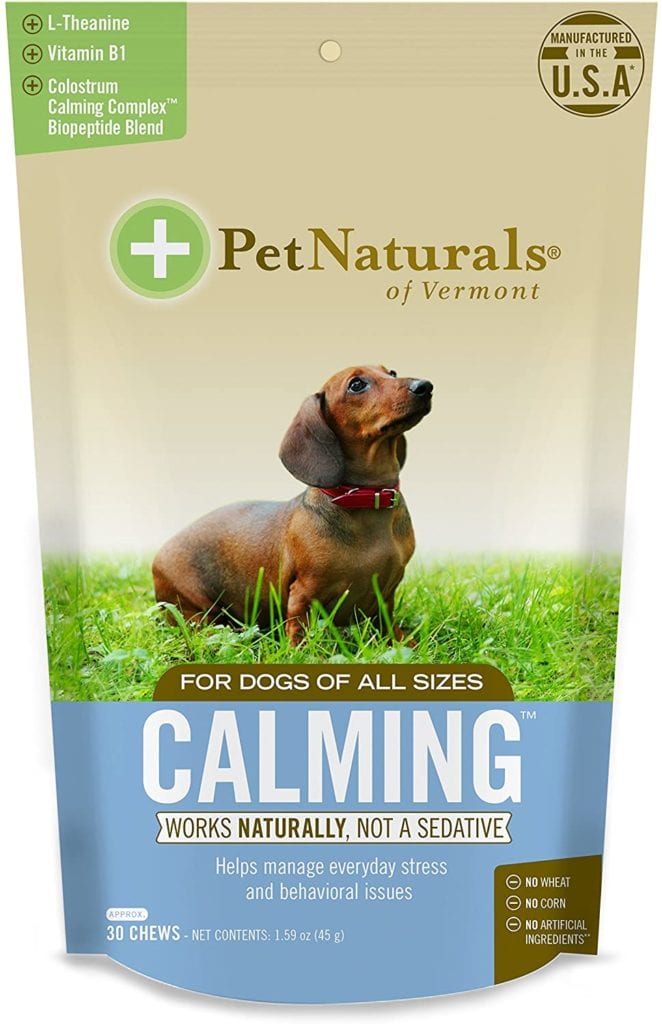
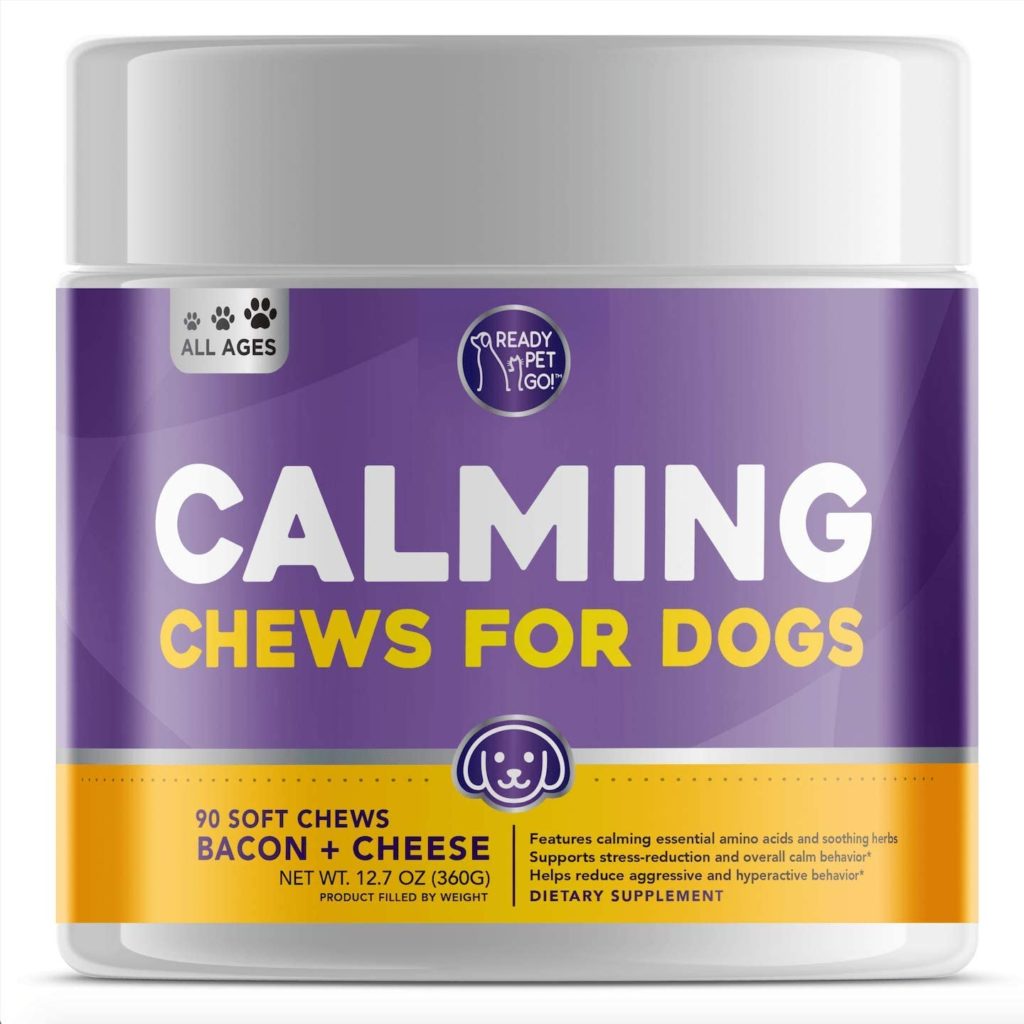
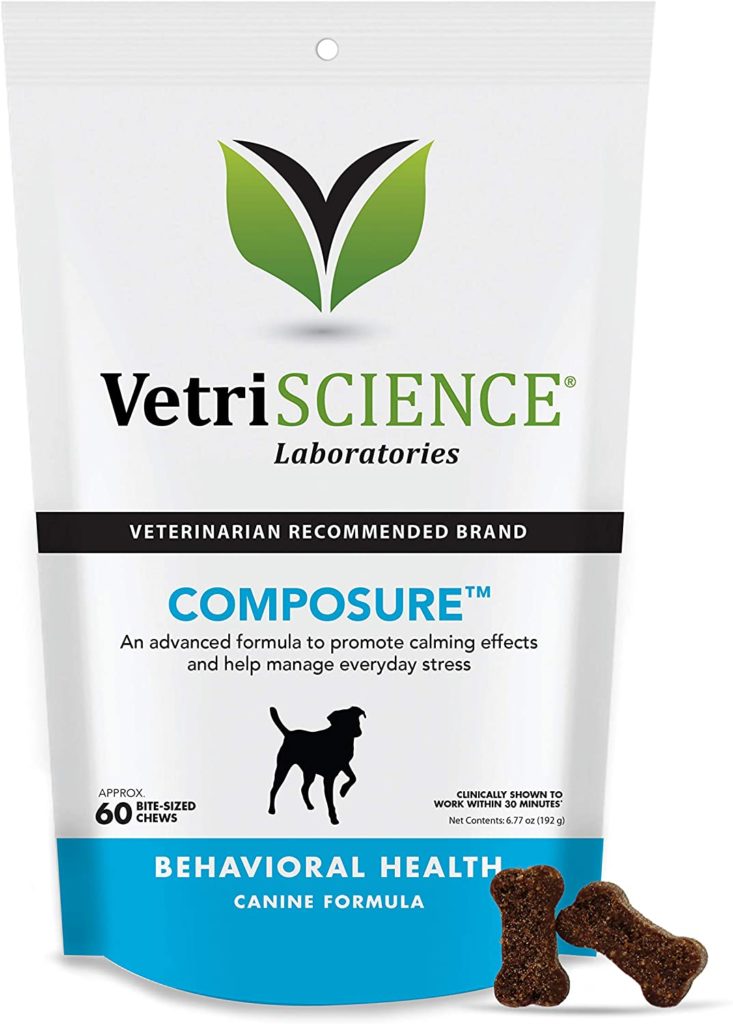


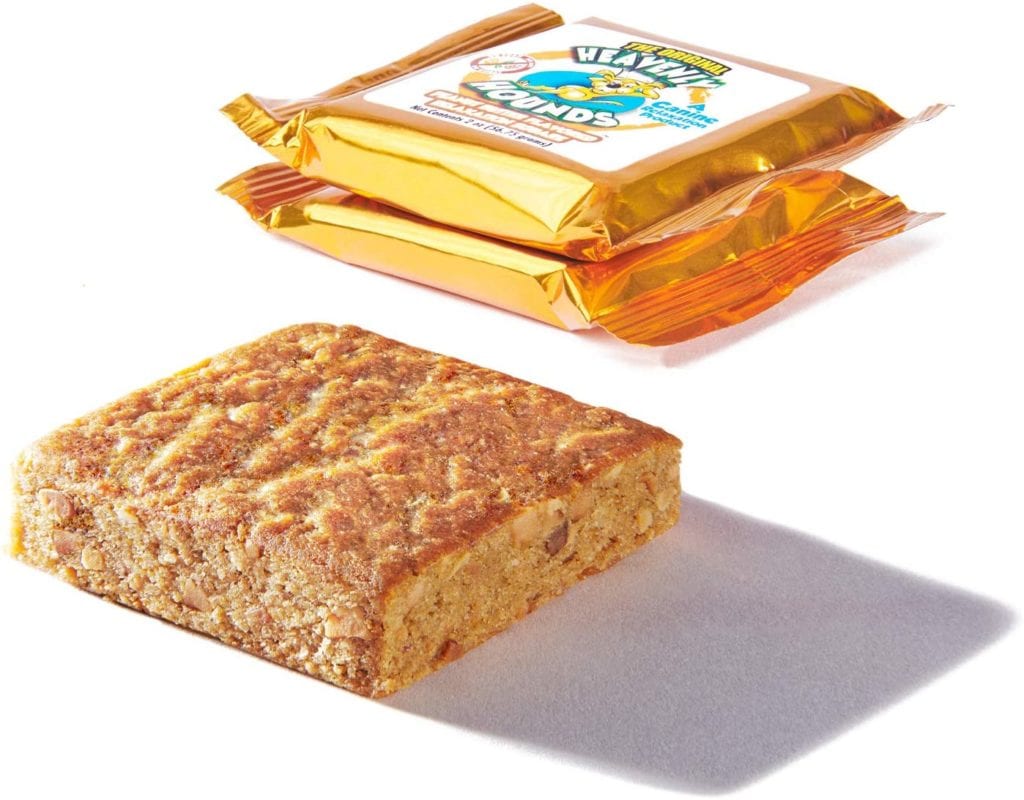
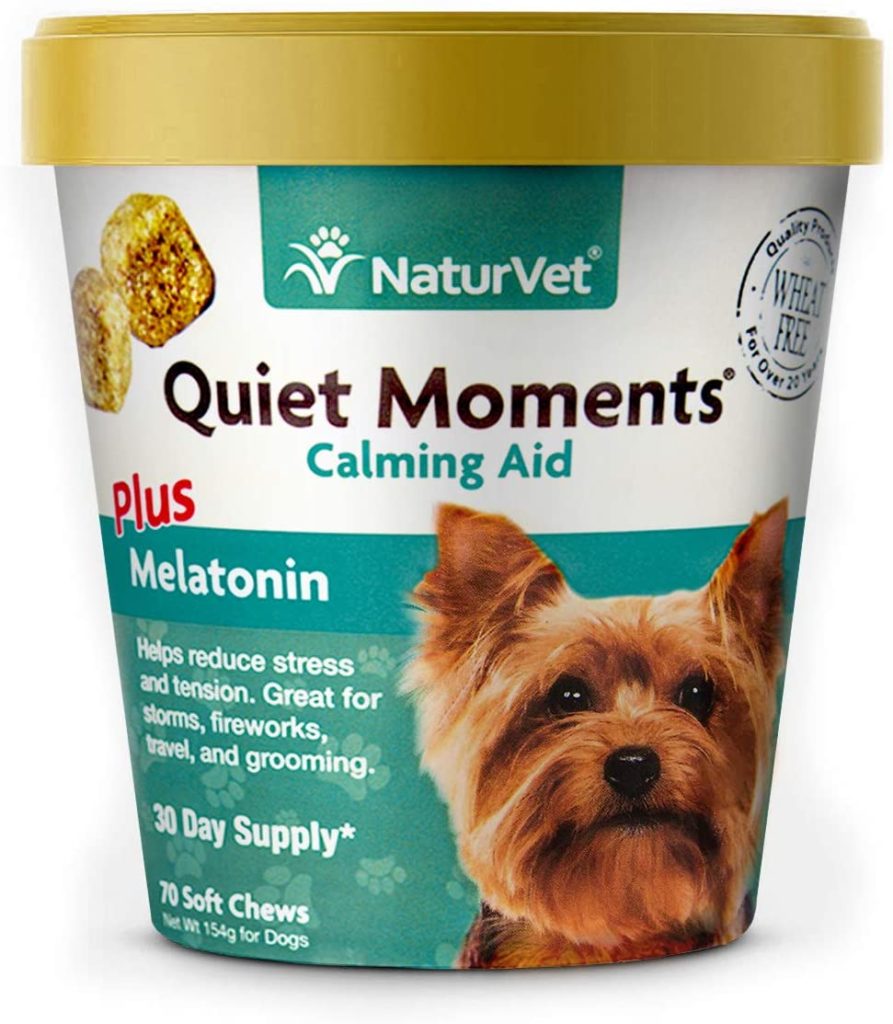
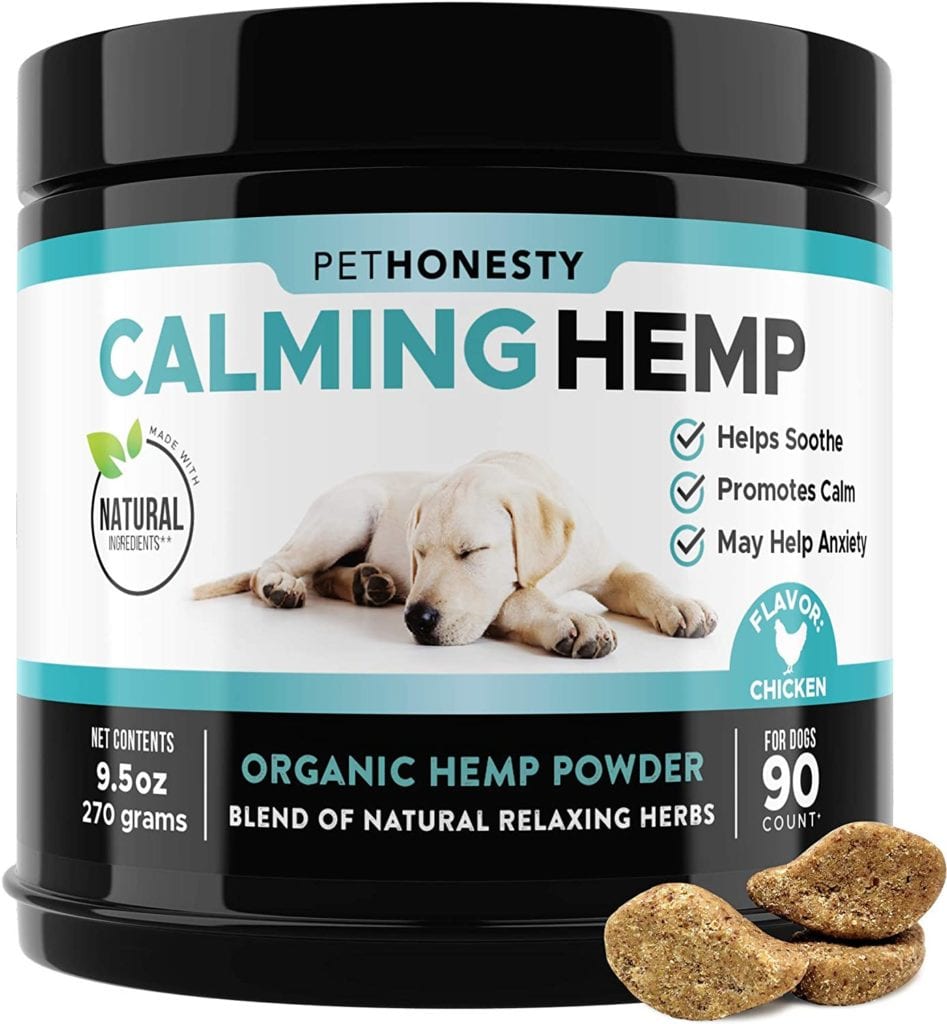
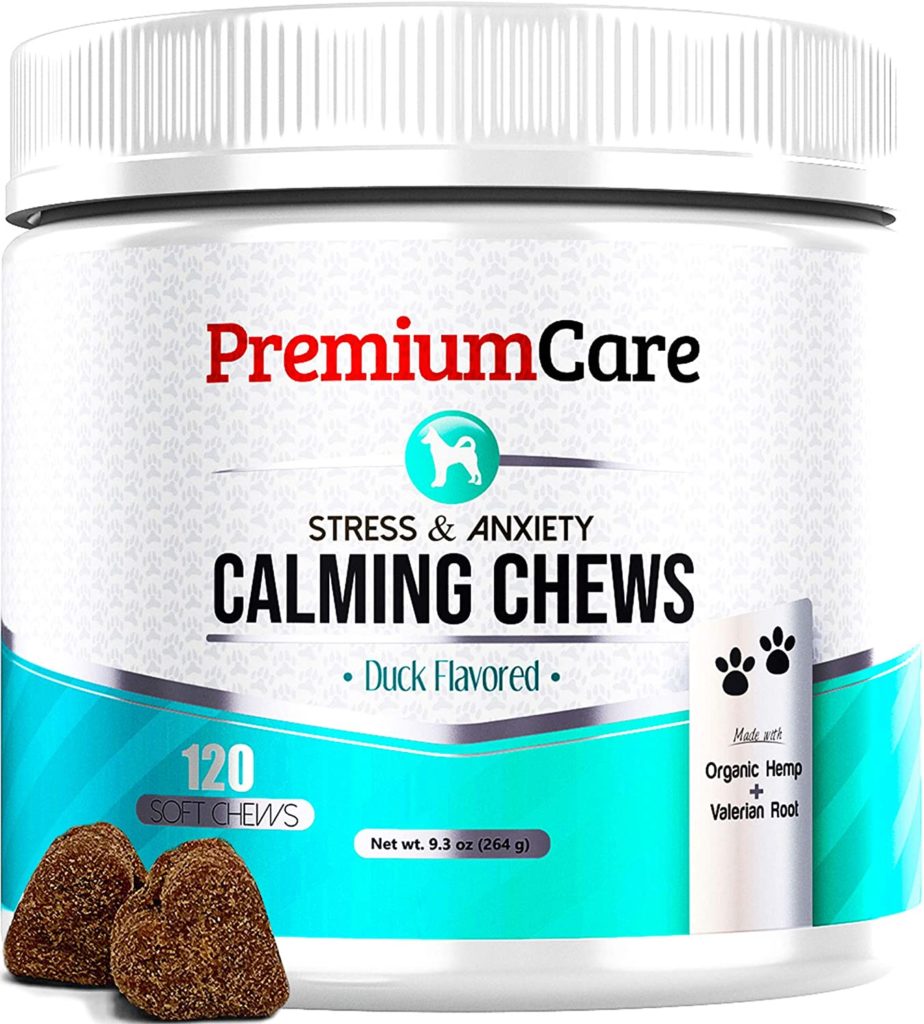
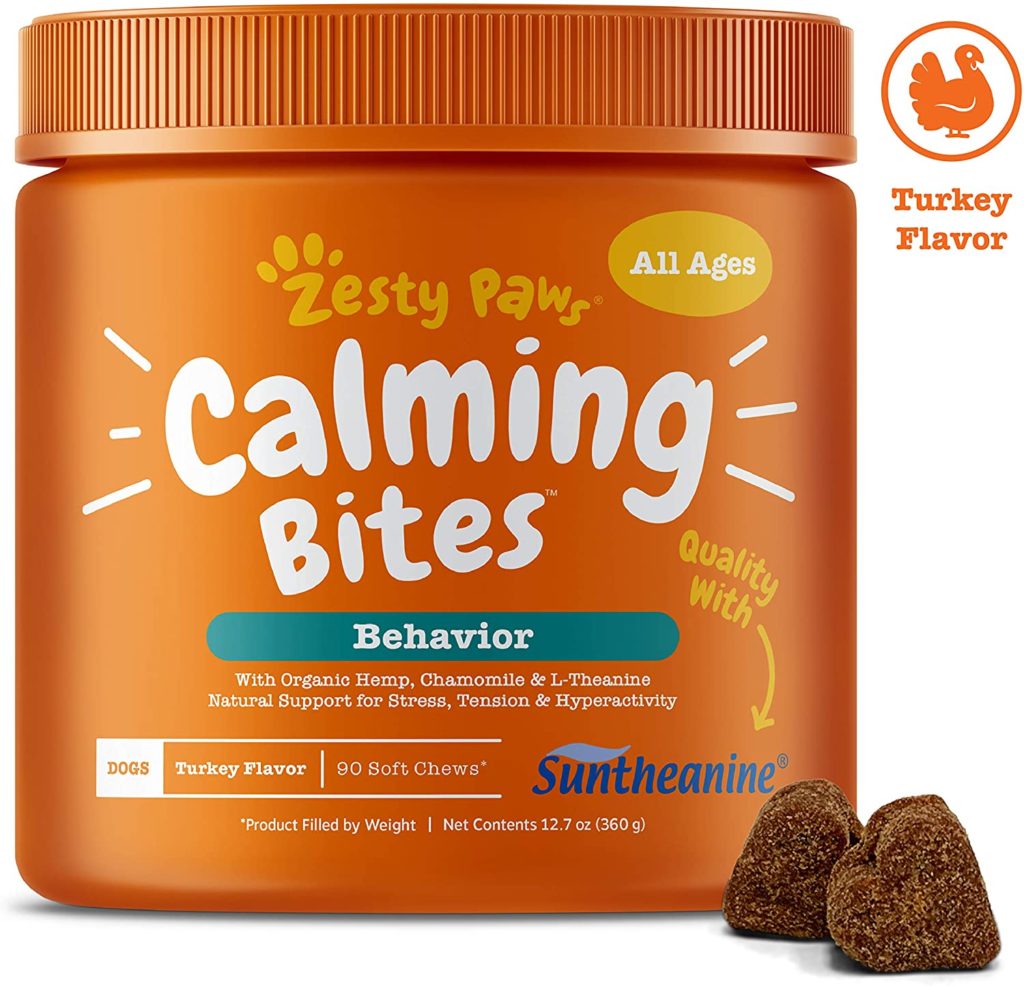
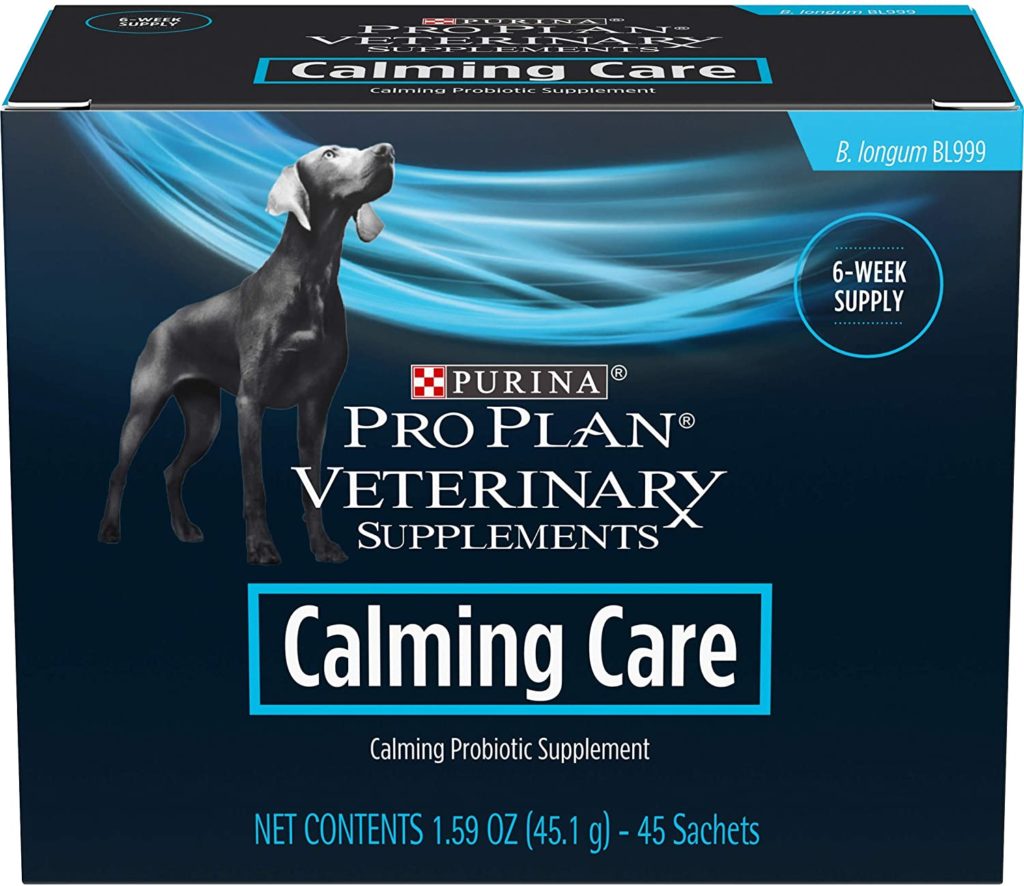




No comment yet, add your voice below!